-
Posts
14,343 -
Joined
-
Last visited
-
Days Won
25
Content Type
Profiles
Forums
Blogs
Gallery
Events
Store
Posts posted by Ed_Haynes
-
-
Similarly this is up for sale, for 6500GBP, described as early 1820-1830, these should have been returned, Contemporary jeweller's copy?
Alex
In this period, I think, the tinsel star would still be the normal award and you could have a metal star made (which, of course, your family would not need to return).
0 -
As you stated Ed, these things were normally returned to the Central Orders Chancery upon the death of the holder if I'm not mistaken, if that's so, how come these "escaped" or are they contemporary Jeweller's copies?
regards
Alex
If awarded to an Indian royal (or their extended family), the families were allowed to purchase the badge at cost. It is not clear whether this policy was ever explained to London.
Likewise, anyone who still had the breast badge in 1917 was supposed to have the badge converted or could purchase (at cost) a new neck badge (and this neck badge would the one that would be returned).
When the CSI was created (along with the KCSI) in 1866 (five years after the order had been creasted as a single-class "great order" along the lines of the Garter, Thistle, or St. Patrick), it was limited to just 100 members at any time, half Indians and half Euroipeans (and half those Europeans had to be reasiding in England, so the order would have some "home visibility"). While these numbers would expand modestly over time (to 225 total by 1939 when the war meant that issues like this would be ignored and awards would be relaxed -- the flood gates would open -- for the war years, there could be 10 civil CSIs per year and 2 military awards), the clear intent was for this to remain an exclusive order (with the CIE added as a less exclusive single-class low order in 1877 and sprouting the higher classes in 1886 and 1887).
After independence, the High Commission gave up on the policy of retrieving awards to Indian recipients on their deaths, while they continued to retrieve (and destroy) awards to Europeans.
0 -
I've wanted one for decades, but won't ever get one. Too bad.
Hugh
And, when you consider the small number of this variety awarded and their return on promotion within the order, it is even nicer. A shame most have no relieble attributions.
0 -
For a sparsely populated country. This figure is still very large.

Well . . . not really.
It is estimated that Mongolia's population in 1950 was around 732,000. By the end of the war against Japan, the MPA was estimated to be around 80,000.
Both A41 and A42 were awarded to both military and civilian personnel. The highest number reported for A41 is 54706 and the highest for A42 is 20008. These are for all types and varieties. While less than scientific, these suggest the scale of total awards.
The precise numbers and ranges awarded to Soviets seem not to have been overly significant to the Mongolians, and this is perhaps understandable. It is believed that the rolls do exist and, whenever research (more roll transcription) gets started, we will know more. Recent political problems have slowed this process as Mongolia has larger issues to worry about.
Yet, compared to the gigantic (some may say profligate) numbers of awards of Soviet medals, the Mongolian numbers are rather small.
0 -
Nice one! I am envious!!!!

 0
0 -
No, this is the final, sinlge-class IOM (1945-47 only). Very care.
The IOM ended in 1947. Custody fights between India and Pakistan (as well as constitiutional and history problems).
0 -
Actually, the CSI is at a bargain price.
0 -
Thanks, friends.
 0
0 -
Thanks, Paul. As you know
 , the time has ome for us to have a "second-generation" reference work that takes us beyond Peterson. In your "spare time"?0
, the time has ome for us to have a "second-generation" reference work that takes us beyond Peterson. In your "spare time"?0 -
Indian wound stripes - worn on the right breast due to the absence of long sleeves on some orders of dress?
What would the dislike of wearing them on the right breast be down to?
Exactly. Almost all orders of dress worn during the war were short-sleeved. No place to put them.
The right breast business was just seen as silliness, something else to bother with, and I have never seen any evidence or heard any accounts that it was even done. The order was just ignored. (Though people got their wound stripes.)
0 -
I am sorry. I was referring to the grouping to Winifred, Lady Hardinge of Penshurst, C.I., K.i.H.
No problem. I was having a "stupid moment" here.
No, all are separate, so she could wear what she wanted to fit on her gown. She probably never had a chance to wear her Kaisar-i-Hind (as she died just a few months after it was awarded) and was one of the very few women to get a 1911 Durbar in gold (though she couldn't wear it out of India (so she would have had a silver "backup").
0 -
Are these sewn together?
Which "these"?
0 -
Winifred, Lady Hardinge of Penshurst, C.I., K.i.H.
Another fringe group to a European, but an important one.
Only portions of her group (Crown of India, Shefkat Order, and lesser doo-dads stripped). Still, pretty.
1- Kaisar-i-Hind, gold, GV, 1st variety
2- Jubilee 1897, silver
3- Coronation 1902, silver
4- Durbar 1911, gold
5- Ottoman: Iftikhar Madalyasi (Sanay-i Nefise Madalyasi), silver - the only medal named
Fringe stuff, but pretty.
Hubby's gongs (Charles, Baron Hardinge of Penshurst, Viceroy of India 1910-16) went separately. Of course. The family group was broken!!
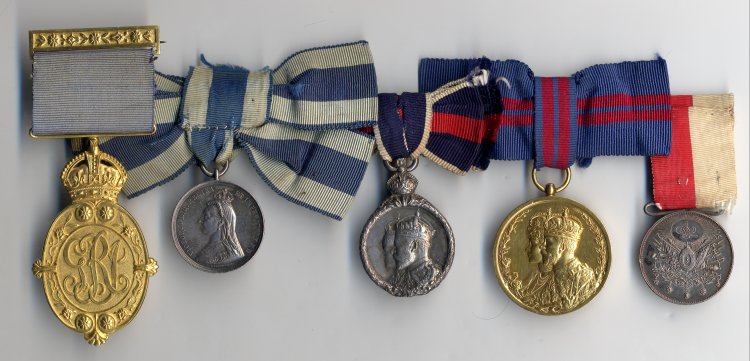 0
0 -
Private John Maxham, H. M. 40th Regiment
Really a FRINGE item for me, but it was too nice to pass up.
1- Candahar, Ghuznee, Cabul - Private John Maxham H. M. 40th Regt.
2- Maharajpoor Star - Private John Maxham H. M. 40th Regt.
A token European pair for my collection!
"Paperwork" in hand. Full Diana Birch research job from the 1970s.

In summary:
Born Hansted, Suffolk, about 1807. A labourer, he enlisted in the 40th Regiment of Foot at Cochester on 21 November 1825, aged 18 years. He served nineteen years and 74 days, 16 8/12 years overseas:
New South Wales and Van Diemen?s Land ? 1 year 11 months
East Indies ? 10 years 10 months
Scinde, Baluchistan, Afghanistan ? 3 years 11 months
Shown as qualified for both medals. No courts martial and conduct shown as ?good?. Discharged 1 February 1845 on account of health, he signed with an ?X?.
Now, someone find me a similar pair named to an Indian and we'll talk a trade . . . .
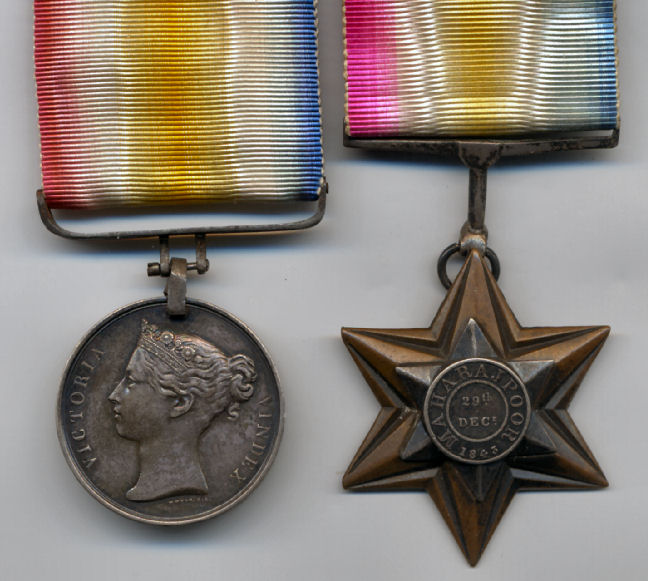 0
0 -
568 Lance-Naik Shan, 7th Mule Corps
1- The India Medal, 1895 - Edward VII - WAZIRISTAN 1901-2 - 568 Multr Shan S & T Corps
2- Tibet Medal - GYANTSE - 568 Dvr Shan 7th Mule Corps
3- India General Service Medal, 1908 - Edward VII - NWF 08 - 568 Lce Naik Shan 7th Mule Corps
A nice "Three Teds" group.
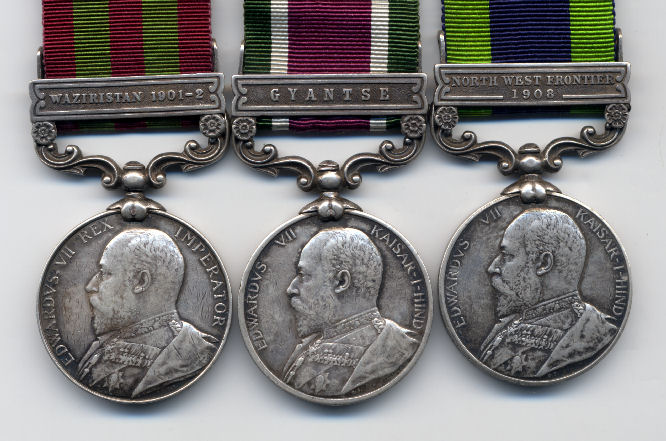 0
0 -
885 Sowar Naurang Singh, Patiala Imperial Service Lancers
1- Queen's South Africa - CAPE COLONY, ORANGE FREE STATE, TRANSVAAL - 885 SOWAR NAURANG SINGH. PATIALA LCRS.
2- King's South Africa - SA 01, SA 02 - 885 SOWAR NAURANG SINGH. PATIALA LCRS.
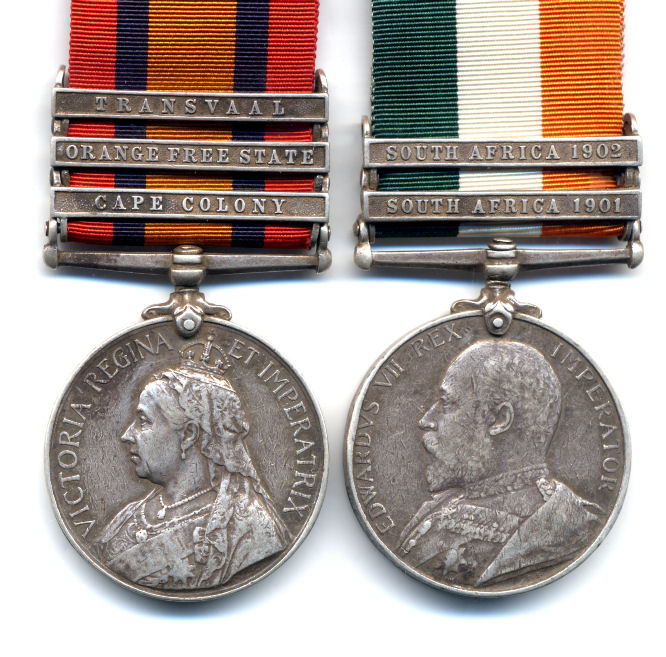 0
0 -
Chief Syrang of Lascars, 2nd Class, Sheikh Essack Baba, Royal Indian Marine
1- Africa General Service - Edward VII - SOMALILAND 1902-04 - "I SEAGUNNY SHEIK ESSACKBABA. R.I.M.S. HARDINGE."
2- British War Medal - "TNDL. SK. ESSACK SK. BABA, R.I.M."
3- Indian Army Meritorious Service Medal - George V, 1st variety - "SK. ESSACK BABA. CHIEF SYRANG OF LASCARS, 2ND CL."
Incomplete group?
 0
0 -
Khan Sahib Bhicajee Dadabhoy, Military Accounts Department
1- Khan Sahib, George V - Mr. Bhicajee Dadabhoy 1st Jany 1920
No. 17-I-C of 1 January 1920 ? Khan Sahib to ?Mr. Bichajee Dadabhoy (retired), Office of the Controller of Military Accounts, 6th (Poona) Division?
F&P, Internal B, February 1920, 436-442:
?Mr. Bicajee Dadabhoy rendered loyal and faithful service to Government for a period over 31 years and retired in December 1916. On offering his services in connection with the war, he has been re-employed on Rs. 250 per mensem since June 1918 and has been of great help to the Field Accounts Officer, Aden, in organizing and running his office where he carried out his duties as Head Clerk, most efficiently. He is absolutely trustworthy, is a well known and much respected member of the Parsi community and the proposed title will be a fitting reward for a long and useful career spent in the service of Government.
?The Local Government has no objection to this recommendation.?
2- 1914-15 Star - B. DADABHOY, MILY. ACCTS. DEPT.
3- British War Medal - KHAN SAHIB ~~~ B. DADHABOY, M. A. D. (renamed by obscuring "MR." and adding "KHAN SAHIB")
4- Victory Medal - KHAN SAHIB ~~~ B. DADHABOY, M. A. D. (renamed by obscuring "MR." and adding "KHAN SAHIB")
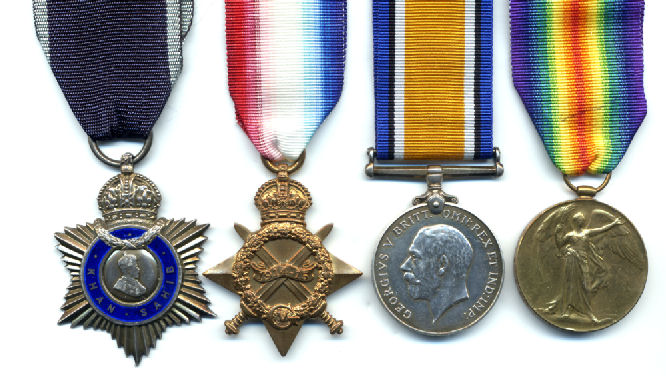 0
0 -
366301/LX21354 Petty Officer Samuel Mascarenhas, Royal Indian Navy
1- Africa General Service Medal, Edward VII - Somaliland 08-10 - 366301 S. MASCARENHAS, OFF. STD. 3CL., H.M.S. HYACINTH:
2- Naval General Sservice Medal, George V - Persian Gulf 09-14 - 366301 S. MASCARENHAS. OFF. STD. 3 CL.. H.M.S. HYACINTH.
3- Royal Navy LSGC, George VI, 1st var - LX.21354 S. MASCARENHAS. P.O.STD. H.M.S. STORK. ? The entry on the service record shows "Traced Medal 03.01.1938". Traced medal normally refers to the LS Medal so the group would appear to be to the same man.
Also entitled to a 1914-15 trio.
Born in Goa 18 February 1886, Occupation before joining waiter. Enlisted 1 October 1907.
Here is what I can glean from his service record (from ADM 188):
? Enlisted as Dom III (Off. Stew. III) 1 October 1907, a ?Man of Colour?, 5 feet 9 inches (though reported height varies from this up to six feet), vaccination left arm and scar base of thumb and scar left ___ [?].
? Served on HMS Hyacinth - The Hyacinth was a 2nd class cruiser (5600 tons), built by London & Glasgow Co, launched 27 October 1898, completed 3 September 1900. She was Flagship East Indies 1907-11, refitted Chatham 1911-12, 3rd Fleet (Nore) attached 5 Battle Squadron, in 1912, Flagship Cape 1913-19, intercepted German merchantman Rubens 18 May 1915 and sank another, the Tabora at Dar-es-salaam 26 March 1916. At Portsmouth 1919 still in service, then paid off until 11 October 1923 when sold to Cohens of Swansea for breaking.
? Ended service 15 October 1910 to ?Shore Bombay?
? To HMS Alert as O.S. II on 14 September 1915 - The Alert was an Alert Class screw sloop, schooner rigged, 960 tons, 4-6in guns, built 28 December 1894 and sold in 1926.
? Leaves ship 24 June 1916 to ?O.R.? (?)
? To HMS Euryalas (Bombay Depot) as O.S. II, 16 January 1917
The Euryalas (Bombay Depot) . . .
? To HMS Pyramus as O.S. II, 5 March 1917 - The Pyramus was a Pelorus class third-class cruiser, displacement 2135 tons , speed 20 knots, crew 224. Armament: eight 4-inch guns, eight 3-pdr, 3 machine guns, and two 18-inch torpedo tubes. HMS Pyramus at the outbreak of world war one was serving in New Zealand and was sent in February 1915 to the Persian Gulf and then transferred to the Eats Indies. After the war was finally scrapped in January 1920.
? Left ship 10 August 1917 to ?Shore O.R.? (?)
? To HMS Jumna (RN Depot, Bombay) as O.S. III, 24 October 1919 - The Jumna (Bombay Depot) . . .
? Left ship 26 October 1919
? To HMS Cornflower as O.S. III, 26 October 1919 - The Cornflower, an Arabis Class sweeping sloop. Launched 30 March 1916, bombed and sunk 19 December 1941.
? Promoted to O.S. II, 1 January 1920
? Promoted to O.S. I, 11 October 1920
? Left ship 24 April 1921, superseded, to ?Shore (Bombay)?
? To H.M.S. Crocus as O.S. II, 26 August 1922 - The Crocus was an Arabis Class sweeping sloop. Launched 24 December 1915, sold July 1930.
? Promoted to O.S. I, 10 November 1922
? Left ship, 29 April 1923 to ?Shore?
? Back to H.M.S. Cornflower as O.S. II, 3 May 1924 - The Cornflower is discussed above.
? Promoted to O.S. I, 4 May 1924
? Left ship 12 December 1926
? To H.M.S. Dahlia as O.S. I, 13 December 1926 - The Dahlia was an Acacia Class sweeping sloop. Launched 21 April 1915, sold July 1932. In dry dock in Malta 1927:
After 1929, his papers are not available and he falls off the radar.
His LSGC is shown as ?Traced Medal 3/1/38? on his service papers. The Stork was a survey sloop of 1190 tons, built by Denny 21 April 1936, converted to an escort vessel in 1939 and sold 3 June 1958 at Troon for breaking.
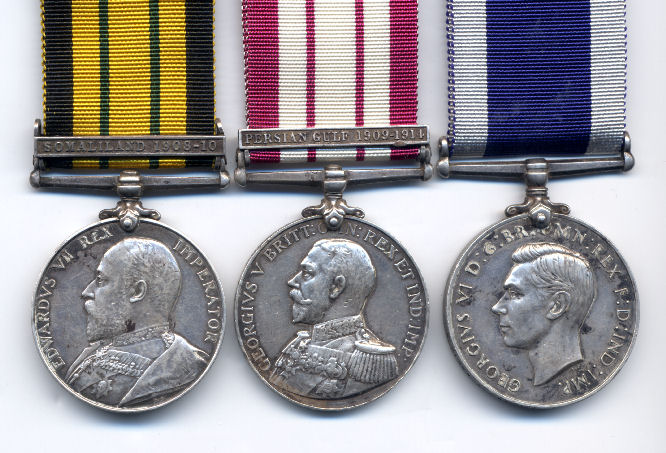 0
0 -
Subadar Major Khan Bahadur Abdul Rauf Khan, Border Military Police and retired Extra Assistant Commissioner, Peshawar, NWFP
1- Khan Bahadur, George V, first variety - Abdul Rauf Khan - retired Extra Assistant Commissioner, Peshawar, NWFP - title 1897 (Foreign Department, Frontier Proceedings, September 1897, 264-287). Badge named "Abdul Rauf Khan". No date on reverse of badge = from the first set of badges awarded, the pre-1911 retrospective awards (the VERY first title badges). Awarded in the context of the 1911 Durbar.
There is quite a story here. Prepare to have your hair curled.
Shown as "Subadar-Major, Border Military Police".
L. W. Dane (Settlement Collector, Perhawar Division), ?Note on the Survey of the Border of the Peshawar District during Settlement 1894,? F, Frontier A, January 1896, 128-147:
?[border from Shamshattu Border Militia Post to Aimal Chabutra, in dispuite since 1869.] In 1893, a serious dispute arose between the Kalla Khel and Adezai owners of the tip [division of produce], and Major Deane, Deputy Commissioner, deputed Subadar-Major Abdul Rauk of the Border Militia to impose it. This was done and the Afridis had to pay their tip as they had not done for years.?
?[border from the Swat River to Hari Chand, Tahsil Charsadda.] As at Darwazgai the only serious chance of a disturbance arose, the history of the case deserves notice. In 1861-62 there had been a dispute between Totai and Tangi about the very area, which is a narrow strip of leven land intersected by nullahs running up to the low pass leading to Span Khara. It was decided by a jirga convened by Mr. Taylor, (sic) Assistant Commissioner, that the land belonged to Tangi, and this strip was accordingly measured at last settlement. Lately the Holy Mullah of Manki in Tahsil Naushera has been in the habit of going to Span Khara in the summer and has acquired great influence amongst the tribes there. As time went on he caused a small house to be constructed near an old Buddhist well in the bed of a nullah on this side of the pass. When I inspecxted this part of the frontier on 15th November 1893 I found that a small area near this had been broken up by trans-border men who were also cultivatring further to the south as well. After references to Major Deane it was decided that the area must be mapped within British territory. It is believed that the Mullah, though a British subject and owning valuable lands in Kheshgi in Tahsil Naushera and Gumati in Charsadda, objected to this, and raiused the tribes, whose attitude at one time was very threatening. Mr. Waterfield, Commandant, Border Militia, went to the spot on 18th April 1894 with a small excort of Border Militia under Subedar-Major Abdul Rauf Khan. Flags apopeared on the hill sides and several thousand men were collected. Mr. Waterfield explained matters to them, and Abdul Rauf went himself to Span Khara to the Mullah and remained there for some time. The result was that the cloud passed off and the area waqs measured on 29th April 1894 by four Patwaris under Abdul Haq, Field Kanungo, and Mir Alam, Deputy Superintendent. . . .
?[Note by Major H. A. Deane, Deputy Commissioner, Peshawar.] The dispute on the Uthman Khel and Ranizai border in regard to Asgarh, Killa and Dobandi was the most serious that we had. . . . The Mullah had obtained great influence among the Utman Khels and the Ranizais, and his object was to put them forward as claimants to the land, keeping himself in the background. He undoubtedly hoped that by a show of force we could be deterred from measuring the land and, if necessary, he intended to withdraw from Spin Khara himself, leaving the tribes to fight for the land. He got together a gathering of some 5,000 men and 87 standards, and as our information was to the effect that in Prangghar, Totai and the villages near the border the inhabitants had removed their cattle and the doors and woodwork from their homes, it was clear that the only chance was to fix the responsibility of the Mullah on the spot. This was done by the dispatch of Subedar-Major Abdul Rauf with a letter to the Mullah from myself [Deane], and with directions to Abdul Rauf to deliver it in person and to establish himself as the Mullah?s guest until he had permission to come away. The Mullah was taken by suirprise, he having made his preparations to leave Spin Khara the next day. He at first refused admitgtance to the Subedar-Major, who, however, was firm and acted all through with the greatest finesse and good sense. The Mullah owns considerable property in British territory and we ahd prevented his family from leaving British territory, which ensured him being careful for the safety of the Subedar-Major. The result of the Mullah?s responsibility being pressed on him was that the armed men found on the border next morning by Mr. Waterfield withdrew when told to do so, and the Mullah later with much entreaty dispersed the gathering. The measurements were then carried out without further trouble. Throughout these boundary disputres, which I was anxious should be settled finallyt without complications being brought about and also without making concessions to the tribes at the expense of our subjects, the Border Police under Mr. Waterfield, Assistant District Superintendent of Poilice, have done excellent service. Under his supervision they have carefully carried out my instructions not to bring about a collision with the tribes, nor to allow a few discontented individuals to force them into such a collision. Although, as Mr. Dane has mentioned in his report, shots were fired by the trans-border men during the measurement operations, not a shot was fired by the Border Military Police. At Dobandi Mr. Waterfield?s coolness and good sense prevailed with a considerable amount of armed men who were at one time within 40 yareds of him. . . . In conclusion, I would say that I cannot speak too highly of Mr. Waterfield, Commandant of the Border Military Police, and Subedar-Major Abdul Rauf in these troublesome matrters and I trust they may be suitably acknowledged by Government.?
F. D. Cunningham to Chief Secretary, Punjab, 8 July 1895, on demarcation of border between Peshawar District and independent territory, F, Frontier A, January 1896, 128-147:
?It is a pleasant duty to draw attention to the credit that is due . . . to the services of the officers of the Border Police, Mr. S. Waterman and Abrab Abdur Rauf Khan; their management of the Kala Khel Afridis, their arrengments for guarding survey parties throughout, and in especial their coolness and resource with hwihc they met the situation created by the sttitude of the Mullah of Manki and his thousands of fanatical clanslem at Dobandi, merit the highest praise, and will no doubt receive full recognition of Government.?
F, Frontier B, September 1897, 264-287, recommendation for Khan Bahadur:
"Belongs to Khalil Arbab Khel family. His services in the Border Military Police have been most distinguished, especially during the recent demarcation of the boundary of the district when, by his personal tact and courage in proceeding alone to the house of the Manki Mullah at Spankhara, he succeeded in securing the dispersion of a large armed body of some 6,000 tribesmen and prevented what might have been a most serious fracas (vide correspondence ending with Government of India, Foreign Department, No. 4636 F., dated 30th December 1895). He has been strongly recommended for this honour by Major Deane and Mr. Merk."
2- India Medal, 1895-1902, Victoria - PUNJAB FRONTIER 1897-98, TIRAH 1897-98 - named "Subdr. Major K. B. Abdul Rauf Khan Border Mily. Police".
Reunited from two very different sorces.
do wonder about a possible missing Durbar Medal 1911, though! These are very hard to confirm. Still, very happy!
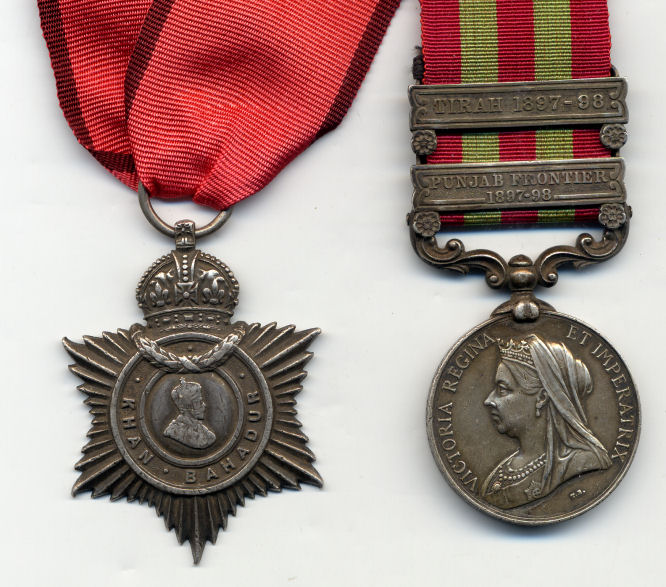 0
0 -
Rai Bahadur Bhupendra Nath Banarji, Deputy Commissioner of Police, Calcutta, Indian Police
1- Rai Bahadur -- Rai Sahib Bhupendra Nath Banarji, Deputy Commissioner of Police, South District, Calcutta, Bengal
Not. No. 316-H of 3 June 1931
F&P 94-H/1931
"Rai Sahib B. N. Banarji is an Imperial Police Officer having been promoted to that rank in 1926, and having acted as Deputy Commissioner of Police, Calcutta, since 1924. For the last six years he has held charge of the South District and throughout the period of his administration has been characterised by initiative and thoroughness. He did exceptionally well in the communal troubles in Calcutta in 1926 and has handled the civil disobedience movement in his district with firmness and success. [!] He has throughout his career proved himself a loyal, industrious, and successful police officer. He received his present title in 1927 and has justified his advancement to the higher title for which he is now recommended.
2- Rai Sahib -- Babu Bhupendra Nath Banarji, Assistant Commissioner of Police, Calcutta, Bengal
Not. No. 21-H of 1 January 1927
F&P 71(2)-H/1926
"Babu Bhupendra Nath Banarji joined the Bengal Police in 1905 and secured promotion to the rank of inspector in 1914 and Assistant Commissioner in 1919. Since 1914, when his services were transferred tro the Calcutta Police, his work has been exceptionally good, and has been distinguished by unusual ability, energy, integrity, efficiency and reliability. Whilst holding charge of Calcutta during the communal riots of 1926, during the first phase of which he was seriously injured in the performance of his duty, he displayed great presence of mind, courage, and perserverance. These qualities and the excellent work done by him at every stage of his career render him worthy of the distinction recommended."
He was, of course, not supposed to have ever worn both badges togetheer (though some did).
3- George V Jubilee, 1935
On roll (p. 58, sl. 459) as "Banarji, Bhupendra Nath - Rai Bahadur - Indian Police, Deputy Commissioner of Police, Calcutta".
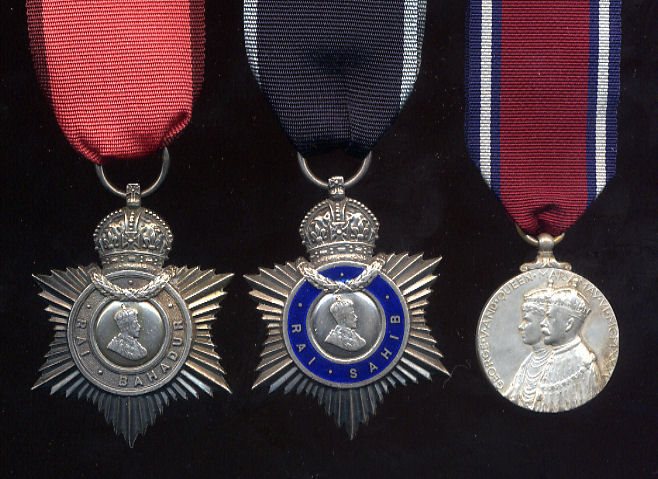 0
0 -
Looks like you inherited my early photo collection as well!

This photo was not Russian Civil War per se, but I really, really liked it. When it was offered to me, I jumped on buying it. The overall texture of the photo, the officer's uniform, the content...just beautiful, I think.
Dave
Dave, I have inherited much. And am a happy custodian. Ed
0 -
Closeup 3
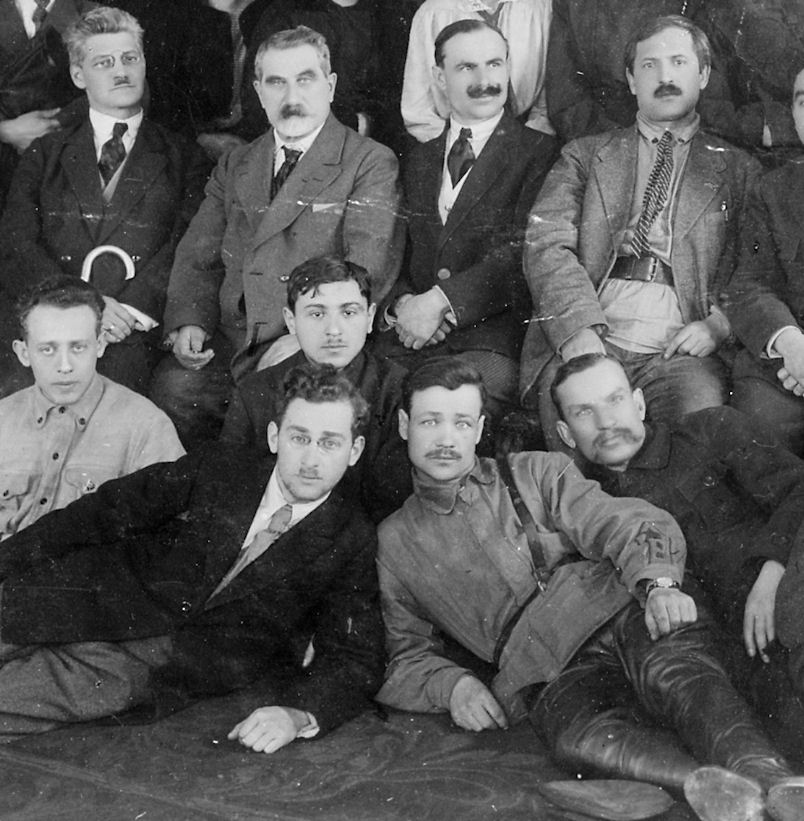 0
0 -
Closeup 2 (with vigilant friend).
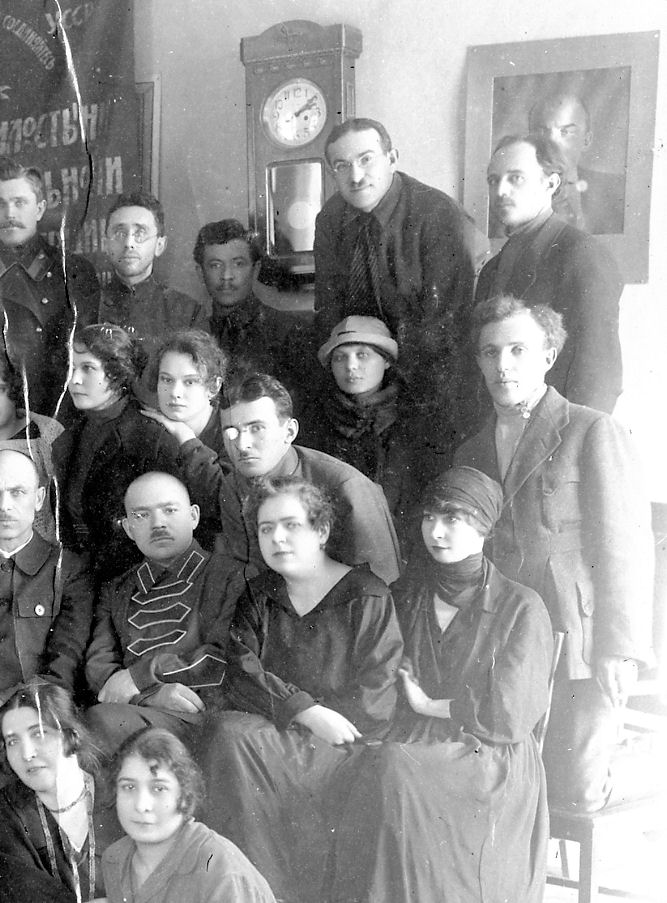 0
0




ARAB MEDALS -- Iraq
in Middle East & Arab States
Posted
Please post what you have. A shame there is (and probably never will be) any archival conformation.